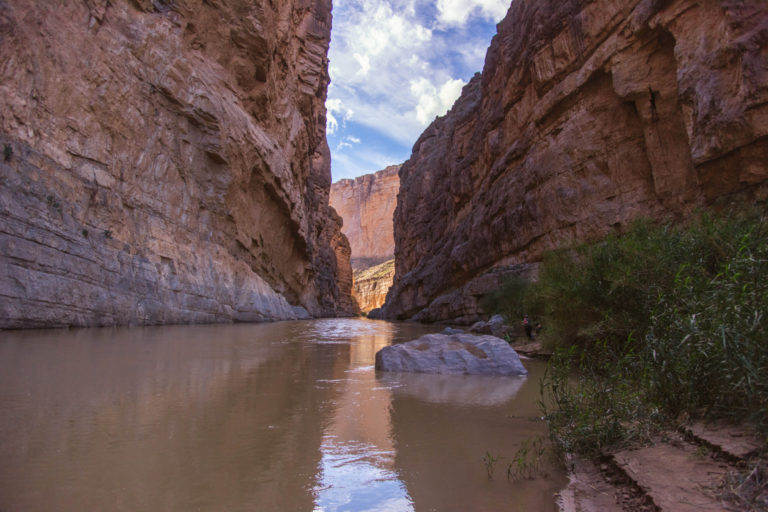On the borderline: Salinity poses problems for farming on Rio Grande

The increasing salinity of the Rio Grande is a real problem for agricultural producers. Experts from Texas A&M AgriLife Research are studying this problem to provide options and advice for those who rely on this water source.
The Rio Grande has made agriculture possible in South and West Texas for hundreds of years or more. Today, the Rio Grande irrigates 2 million acres of land and is home to many of Texas’ agricultural state symbols. Pecans are the state tree and nut, cotton is the state fabric and fiber, red grapefruit is the state fruit and the Texas-developed sweet 1015 onion is the state vegetable.
Other crops such as sorghum, sugarcane and alfalfa might not be state symbols, but they have the distinction of contributing hundreds of millions of dollars to the state and national economy.
To understand agriculture along the Rio Grande, one must first understand “where the water comes from, the volume and how the water drains,” said Juan Enciso, an AgriLife Research irrigation engineer at the Texas A&M AgriLife Research and Extension Center at Weslaco. Enciso is also an associate professor in Texas A&M University’s Department of Biological and Agricultural Engineering, administered by the College of Agriculture and Life Sciences.
As the Rio Grande makes its way from its snowmelt-fed headwaters in Colorado to its outlet in the Gulf of Mexico, 80 percent of the water is diverted for agriculture.
“We are a very dry state and we don’t have enough water,” Enciso said. “We have to be very careful about not overusing the water.”
Many of the crops, like pecans and alfalfa, require a lot of water, said Girisha Ganjegunte, AgriLife Research water resources and salinity management research group leader at the Texas A&M AgriLife Research Center at El Paso and a professor in the Department of Soil and Crop Sciences.
“Because of high evaporation and high agricultural operations, you need a lot of water to grow the crops,” he said. “The irrigation water depth is measured in feet here, not in inches.”
With global temperatures rising, drought becoming more common and snowpack at the headwaters of the Rio Grande decreasing, water is getting scarcer. This forces producers to choose which crops to prioritize.
“During periods of drought, people divert all that water to salvage pecan crops because it’s a tree crop, and it takes years to produce,” Ganjegunte said. “So, if you kill it, then you have to wait for 10 years again. But in the meantime, payments to the bank won’t stop.”
Ganjegunte said the water producers use to irrigate and the soil the crops grow in are saltier than many crops prefer, and it’s getting saltier still.
The agricultural soil along the Rio Grande is naturally somewhat salty and because of the geological formations, the groundwater tends toward saltiness. This presents a problem for both municipal and agricultural water users in the region. El Paso pulls 50 percent of its drinking water from groundwater. Pecan producers who can afford it drill wells hundreds of feet deep, but the aquifers get saltier as they get deeper.
Surface water, meanwhile, comes from the Rio Grande. Ganjegunte said the Rio Grande’s water is “pristine” at its headwaters in Colorado. By the time the river reaches El Paso, the salinity of the water is above 1,000 parts per million. Water above 1,000 parts per million is not fresh and, while still safe to drink, is above secondary drinking water standards.
As the Rio Grande’s water journeys toward the Gulf of Mexico, it passes through both urban and agricultural land. Booming populations on both sides of the border means more people are using water softeners. Water softeners are salts that are discharged with wastewater. Because wastewater treatment doesn’t remove salts, they all end up in the river.
Meanwhile, on agricultural land, salt-containing fertilizers can enter the river through drainage. As that water is used for irrigation, more salt is put into the soil.
“It’s a combination of different things: population growth, more wastewater, more softeners, fertilizers,” Ganjegunte said. “So, over time, the salinity is going only up and up and up.”
If enough freshwater comes into the soil regularly, such as from rain, salt is leached out of the soil, said Genhua Niu, AgriLife Research professor of urban agriculture at the Texas A&M AgriLife Center at Dallas. But along the Rio Grande, rain can be hard to come by.
El Paso County, for example, has an annual precipitation of nearly 9 inches. Potential evapotranspiration — how much evaporation there would be if enough water were available — is around 78 inches, Ganjegunte said. That means on average the local climate is capable of evaporating nearly nine times more water than the amount that actually rains down each year.
Decreasing water levels in the Rio Grande further concentrate the salt in the soil with little rain to leach it away. Even if there was more rain, the local soil — fine soil deposited by the river and clay-heavy agricultural soil — isn’t very permeable, so it’s hard for water to get in to leach salt out.
Irrigating with salty water, which is the only water available, creates a self-perpetuating problem, Niu said.
“The rainfall is so little, so water is constantly evaporating. If you are irrigating a pecan orchard or a field of cotton, the salinity gets worse with more irrigation, because there’s no pure water,” she said. “Then water will evaporate. As soon as the water is lost in the atmosphere, you have no control. But the salt stays there forever.”

